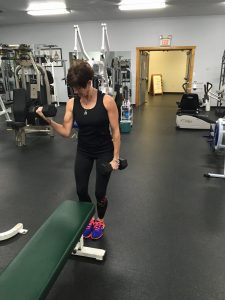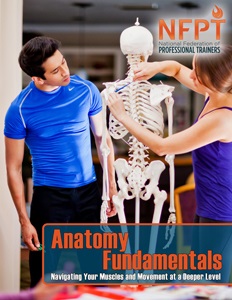When personal trainers understand biceps anatomy and mechanics they’re able to cue clients more effectively, address strength imbalances, minimize risk of injury, and enhance training results. You can do all of this and more by answering one simple question!
How does changing your grip affect a biceps curl?
This is a common question both personal trainers in my workshops and clients ask me. They want to know what the difference is between holding the dumbbell with a pronated grip, supinated grip or neutral? Is it just for fun?
The simple answer: Changing the way you position the dumbbell changes which muscles are recruited as well as the moment arm of the resistance. Not just in your elbow, but in the joints nearby as well and in the way you hold your spine for stabilization. An EMG is the only way to know which muscles are working for sure and could change from person to person depending on their unique lever lengths (bone size). But, knowing the anatomy of muscle attachments gets us one step closer to EMG status and helps you feel if you have symmetry in your muscle recruitment.
But, perhaps you want to know more. Go deeper. Really understand what’s happening…
Let’s go over each type of biceps curl exercise, how to add more variety to this seemingly simple exercise and then review the four biceps muscles that are each slightly different from one another.
#1 Supinated Grip Biceps Curl

Kelly Bianco
Your palms are facing the sky with this grip. Anatomically, the radius and ulna are parallel to each other. All of the elbow flexion muscles are lined up well to help with this exercise.
Place your hand on the center of your arm on the front where the biceps muscle is classically known to be. Pronate and supinate. Notice how your muscle bulges when you supinate. This is the brachialis muscle that is bulging. So, perhaps it’s working more in this position? Perhaps!
#2 Neutral Grip Biceps Curl
Your palms are facing your sides throughout the entire motion with this grip. Place your hand on your proximal (close to elbow joint) radius and ulna. Feel what happens when you move from a supinated position to neutral. The radius stacks on top of the ulna. This brings the biceps brachii muscles and brachioradialis front and center, possibly utilizing them more than the brachialis.
#3 Pronated Grip Biceps Curl
Your palms are facing behind you and then the floor with this grip. Remember how the radius and ulna were parallel in supination stacked in the neutral grip? Now they are crossing over each other. This brings the radius into even more alignment with the humerus, changing muscle recruitment once again.
Bicep curling awareness
Have you ever had a client who was stronger doing biceps curls on one side than the other? Or who complained of discomfort when curling on one side and not the other? Knowing where the muscles attach, being aware of them and cueing are all connected to body awareness.
Try This
Ask a client where they feel muscles contracting in each of the three exercises above. Ask if they feel the same sensation on the right and left sides. Then, show them where the attachments are for each muscle and encourage them to feel each muscle working. Review one at a time with them to keep it simple. Of course, try this on yourself first!

Vincent Russo, NFPT CPT
Adding variety to biceps exercises
Aside from doing bilateral curls (both arms at the same time) and unilateral curls (one at a time) you can use bands or cables instead of dumbbells.
What’s the difference? The line of pull changes. Especially if you attach the band or cable in front of you versus attaching it low on the ground. Different muscles are recruited to stabilize when you change where the band is attached.
Of course, you can also make the repetitions slower, faster, pulse them or just hold the exercise in the hardest position (which is at 90 degrees).
Try starting with a neutral grip and rotate into a supinated or pronated grip by the time they get to the top of the motion.
Vary biceps exercises even further
One of my favorite exercises to do when varying biceps curls is circles. Start with the dumbbells in neutral grip at your sides. As you curl start to supinate. Once you reach full elbow flexion and the dumbbells are at your shoulder then externally rotate your shoulder bringing the dumbbells and your wrists away from your body but keeping your elbows anchored.

Four biceps muscles – anatomy review
There are technically two biceps muscles in your arm. But, if you’re doing a biceps curl, then any muscle crossing the elbow joint on the front side and influencing elbow flexion is likely to be recruited for the movement!
Knowing where all of the elbow flexion muscles attach helps you feel which ones are being recruited most in each of the different biceps curl exercises below. Find each attachment point on yourself and then on a partner. Use a balloon on a partner to look at how the muscle shortens during a curl.
Biceps Brachii Short Head – Coracoid Process of Scapula to Radial Tuberosity
Biceps Brachii Long Head – Supraglenoid Tubercle of Humerus to Radial Tuberosity
Brachialis – Anterior Humerus to Coronoid Process of Ulna
Brachioradialis – Lateral Supercondylar Ridge of Humerus to Styloid Process of Radius (Distal Point)
Learn more anatomy with NFPT’s Anatomy Fundamentals Course.
References
Abrahams, P.H. et al. 2003. McMinn’s Color Atlas of Human Anatomy. London: Elseiver.
Muscolino, Joseph E. 2004. Musculoskeletal Anatomy Coloring Book. Philadelphia, PA: Mosby, Inc
Beverly Hosford, MA teaches anatomy and body awareness using a skeleton named Andy, balloons, play-doh, ribbons, guided visualizations, and corrective exercises. She is an instructor, author, and a business coach for fitness professionals. Learn how to help your clients sleep better with in Bev's NFPT Sleep Coach Program and dive deeper into anatomy in her NFPT Fundamentals of Anatomy Course.


